Maandagmiddag, 15.45 – 16.45. Zon, nauwelijks wind. Toch nog een rondje (laatste van het jaar) ondanks veel werk. Kenmerkend voor dit jaar: een rondje van nauwelijks een uur.
Marcusstraat – Amstel – Ouderkerk – Holendrechterweg – Ouderkerkerplas – langs snelweg – Amstel – Marcusstraat
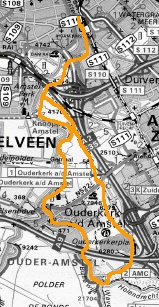
Ik weet bijna zeker dat ik al 156 ritjes had gemaakt, ik ben een ritje vergeten tussen de 13e en de 26e. Ik heb lang genoeg niet kunnen rijden door het weer (veel sneeuw). Op Tweede Kerstdag scheen de zon en reed ik in de middag het meest klassieke rondje: de Ronde Hoep.
Marcusstraat – Amstel – Ouderkerk – Ronde Hoep – Ouderkerk – Amstel – Marcusstraat
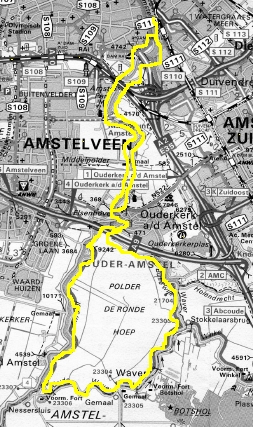
This is of course what should happen:
“The most ambitious solution would transform Google’s digital database into a truly public library. That, of course, would require an act of Congress, one that would make a decisive break with the American habit of determining public issues by private lawsuit.”
See Robert Darnton’s article in the NYRB: Google and the New Digital Future
I’m afraid it won’t happen. Never.
Think about his too, having it done in another way:
“… with none of the missing pages, botched images, faulty editions, omitted artwork, censoring, and misconceived cataloging that mar Google’s enterprise. Bibliographers—who appear to play little or no part in Google’s enterprise—would direct operations along with computer engineers. Librarians would cooperate with both in order to assure the preservation of the books, another weak point in GBS, because Google is not committed to maintaining its corpus, and digitized texts easily degrade or become inaccessible.”
I had just read a new text by Douglas Kahn in which he refers to works by Gordon Mumma, so the programming of a tape piece by Mumma at DNK came at exactly the right time. It was a cold night, and at 22.00 there were still only about 7 people: exceptionally quiet for a DNK concert. It might have been the cold, it might have been the promise of a tape piece. Martijn Tellinga did a short eloquent introduction and played Mumma’s Megaton for William Burroughs. I do not know why he chose that particular piece, but it was nice. Sometimes harsh sounds, also very beautiful spatializations over two speakers. And then something strange happened in the sound, a soft knock, a sound that sounded like a very cautious footstep. I had my eyes closed so I didn’t see anything. It happened a few times more. When after a while I opened my eyes I saw that the light behind the curtains had come on. After the piece was over – it ends with a recording of a drummer playing a steady rhythm on cymbals – it turned out that about nine people had been let in, through the entrance behind the curtains, to not disturb. Seamus Cater wasn’t amused, and it did destroy some of the enjoyment of the piece, but in a sense, it was quite funny – most of the nine behind the curtains were regular DNK-visitors, and I couldn’t be mad at them.
After the break it was Robin Haywards, solo on tuba. I’ve hear him a few times before – never solo – and you know you’re in for very quiet, intens music. I love the sound of the tuba, and sometimes I find myself craving for ‘some real tuba’ by Hayward (I can image that he can produce beautifull conventional tones on the tuba too). Hayward focusses exclusively on the ‘other’ sounds of the tuba, the breath, air through the tube without producing a note, flurries, noises, using circular breathing. He played 4 pieces (or imporvisations), in the first two he focussed on the noises and breathing, in the third one he did make a tone, or almost. He produced amongst others flurries of notes that sounded like, yeah what, the membrane of a loudspeaker moving physically, flabbing, producing both a tone, external noises and some overtones (?), all at the same time, and he build a pulse from that. I was impressed more than ever before by his playing. There are vast unexplored worlds in very soft sounds. The fourth piece – he was already playing for quite a long time, much longer than I’d anticipated – was cut off by someone leaving. He took that as the call to stop. It was late already.
Koud, vond ik het. Noordoostenwind en een zonnetje. 3 graden. Klein rondje, want ik was moe.
Marcusstraat – Ringdijk – Nesciobrug – Diemerzeedijk – Durgerdam – Holysloot – Ransdorp – Schellingwouderburg – Marcusstraat
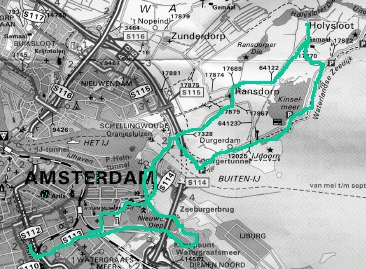
Last monday there was a double bill featuring the young Australian bass-player Mike Majkowski. His playing is stunning and subtle. In both the solo performance and in the group with Laura Altman (clarinet), Yolando Uriz (piccolo) and Angel Faraldo (computer) he focusses on textures, mostly playing with the bow, though he is capable of producing a full bodied bass sound too. Also the group improvisations are focussed on creating refined textures of bass, clarinet and flutes, with the computersounds sometimes dominating a bit (though in the last piece we got a very nice low bass from the laptop which fitted perfectly). Concentrating, deep listening, textures. They announced that they finally had come up with a name for their group, but I’m afraid I forgot what it is (I do remember it was a combination of their initials). Good concert. I don’t know many bassplayers with such a command of extended and alternative techniques.
Zonnetje. Klein middagrondje tussen het werk.
Marcusstraat – Diemerpark – Muiden – Bloemendalerpolder – spoorbrug – Driemond – Stammerdijk – Bijlmer – Weespertrekvaart – Marcusstraat
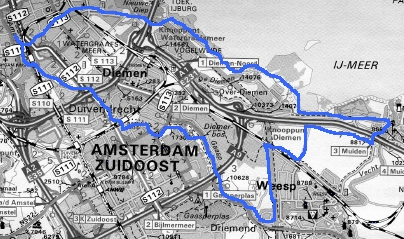
Laat zondagochtendrondje. Eerst nog droog en bewolkt, later miezer. Somber decemberweer, wel lekker gereden. Flinke zuidwestenwind. 11.00 – 12.30
Marcusstraat – Amstel – Kalfjeslaan – Amsterdamse Bos Noord – Jac. Takkade – Bovenkerk – De Poel – Amstelveen – Ouderkerkerlaan – Ouderkerk – Amstel – Marcusstraat

Somber decemberweer, droog (na regen), waterkoude wind. Moe. Veel (of te veel) te doen.
Marcusstraat – Ringdijk – kanaal – Driemond – Gein – Abcoude – Ouderkerk – Amstel – Marcusstraat
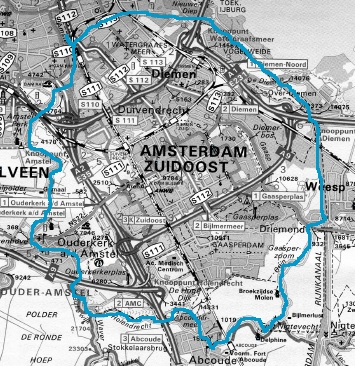
I missed a few DNK-concerts in the past weeks. I had either a job to finish on a monday night, or I was ill, or both. But yesterday I was there to witness a performance of The Pitch. As I know Koen Nutters personally, I was well aware of the existence of this group. They’ve been rehearsing for a while now, whenever all of them could be in Berlin. These weeks they’re on a tour through Europe, and arrived at what to me feels as ‘homebase’. In The Pitch Morten Olsen plays vibraphone, Koen Nutters double bass, Michael Thieke clarinet and finally there’s Boris Baltschun who plays a small 1950s pump organ. (Is it a pump organ? They list it as such).
On a French site I read the term ‘deep acoustic’ to describe their music, and I find that quite fitting. The Pitch play structured improvisations that lead to music which is simply beautiful. The music only changes slowly, it is a layering of pitches. A note from the organ, a bowed note from the bass, a bowed note and a soft repeated single note from the vibraphone (or maybe one motif), and a note from the clarinet: it weaves a ‘tapestry’ which indeed is sometimes remininiscent of Feldman (the one influence they mention). I liked it, especially the one real drone piece, in which the sounds really seemed to take off. (Well, that’s what happens during a good drone). In that piece it almost became impossible to distinghuish exactly from which instruments which sounds were coming, and the spatial aspect of the sound (sound creating the space) was foregrounded even more. There is not a lot of tension in this music – or no tension at all even (though it never is boring). It is simple, and simply beautiful. The intention seems to be to create a soundspace in which one (player and listener) can simple ‘be’ for a certain amount of time. Also as a listener I am quite into exploring such an area.
After the applause for the last piece, the musicians retired backstage. Half a minute of silence followed and almost nobody got up to get drinks. Three people began to applaud again, the rest of the audience followed. In the concentrated and restrained atmosphere of DNK, The Pitch played an encore.





